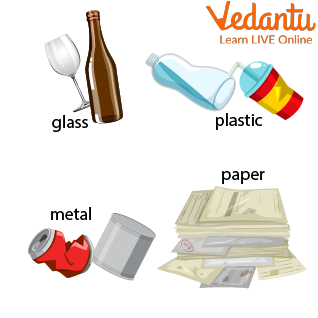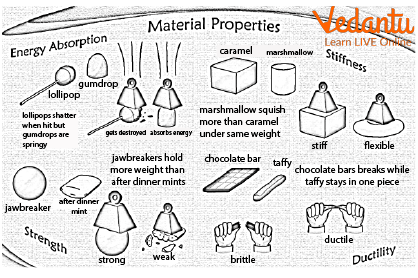




An Introduction to Different Types of Material
There are many types of materials that are most commonly used in daily life. The knowledge of different types of materials allows for the comparison of everyday materials, for example, different types of wood, rock, metal, paper, and plastic, according to their properties.
The properties of material include hardness, strength, flexibility and magnetic behaviour. Different types of material and their properties can be used in the making of many different objects which can be used in day-to-day life. For instance, the hardness of iron, ductility of gold, and silver, the conductivity of copper etc. Let us learn more about such materials and their properties ahead.
Different Types of Materials
Biomaterials
A biomaterial is any substance that can be engineered for interaction with biological systems for a medical purpose. For example, they are used for therapeutic purposes, i.e. to treat, augment, repair or replace a tissue function of the body or a diagnostic one. The study of biomaterials is known as biomaterials science or biomaterials engineering. Biomaterials science encompasses the elements of medicine, biology, chemistry, tissue engineering and materials science.
Ceramics
Ceramic is a non-metallic material made up of inorganic molecules. The ceramic is normally prepared by heating a powder or slurry. So many common ceramics are made up of oxides or nitride compounds, high in a crystalline form with long-range molecular order. The ceramics are halfway or fully amorphous and with no long-range molecular order. These are typically classified into glassy materials.
Metals
The metals are malleable comparatively. The metals are optically reflective and electrically conductive. Mostly the metals and alloys can be easily shaped by forming. The metals disassociate electron bonding and make them good conductors of electricity and heat. Each metal has an orderly arrangement of atoms, resulting in a crystalline structure that may have multiple crystal phases bordering each other.
Nanomaterials
The nanomaterial is defined as the material with any external dimension in the nanoscale or having an internal structure or surface structure in the nanoscale. The nanoscale is defined as the length range, approximately from 1 nm to 100 nm. This includes both nano-objects and nanostructured materials.
The nanomaterials are discrete pieces of material, and the nanostructured material has an internal or surface structure on the nanoscale. The nanomaterial can be a member of both these categories.
Wood
Wood is called a composite material. It is made from lignin and cellulose. It uses a lignin matrix and cellulose fibre to form a polymer composite. The lignin helps to hold the cellulose compressively in place so that the cellulose fibre can carry the tensile loads. Wood has excellent structural properties in light of its low weight and high strength.

Different Types of Materials
Different Types of Materials and Their Properties
Materials can also be explained based on their properties. It is important to understand the material's properties to decide whether the material is suitable for its use. When we talk about a material's properties, we mention the features we can sense, measure or test. For example, if we have any kind of sample of metal in front of us, we can identify what the colour of that material is, whether it is hard or shiny.
Testing the materials shows that they can conduct heat and electricity and that they will react with an acid. These are some properties of metals, which enable us to identify them.

Image Showing Properties of Different Materials
Physical and Chemical Properties
Almost all materials contain physical properties. A physical property is a property that a person can measure without changing the material. Examples of physical properties are colour, amount, hardness, and temperature.
Similarly, materials also have chemical properties. A chemical property tells us how a material will change into a different substance under specific conditions. For example, some metals rust if they are kept out in the rain. Paper and wood burn to ashes if they come in contact with the flame.
Summary
Any type of substance used to make something is known as material. For example, the school desk can be prepared from wood, plastic, or metal or a mixture of all three materials. When any kind of object is designed and made, it is very important to choose the best material for the job. Materials have certain qualities or properties. For example, the properties of materials include strength, colour, and hardness, which must be considered carefully. Some other factors, such as cost and availability, are also important.
FAQs on Different Types of Material and Their Properties
1. What are the materials? Define in short.
Materials can be natural or artificial. They can be made from living or non-living things. The material that has not yet been used or changed in any way is known as raw material. Natural materials will be exhausted one day so they must be used carefully and replaced wherever possible. This is described as the sustainable use of all resources that come from nature.
Different types of materials have different kinds of properties. Materials can be soft, hard, flexible ( can be bendable), rigid (can be stiff), transparent (we can see through it), opaque (means the light does not shine through it), rough, smooth, shiny or dull. For example, the glass material is transparent, hard and smooth.
2. Explain the materials from living things and materials from non-living things.
Wood (used for making school benches), paper (used for making books), and cardboard (used for making boxes) all are made from trees. Leather (used for making jackets) comes from cattle skin; wool is made from sheep and cotton is made from plants. All these are the material of living things.
Metals and precious gems, for example, diamonds, are excavated from rocks in the ground. Materials like chalk, clay, coal and sand are also examples of nonliving things. There are some materials that are a mixture of living as well as non-living things. For example, the soil is made up of tiny organisms, dead plants, stones, tiny particles of rock, air and water.
3. Describe some of the physical properties of metals.
1. Strength - Metals have high tensile strength.
2. Ductility - Metals can be drawn into thin wire without breaking.
3. Malleability - Metals can be drawn into thin sheets without breaking.
4. Melting and Boiling Points - Metals have high melting and boiling points.
5. Conductivity - Metals are good conductors of heat and electricity.
6. Lustre - Metals are lustrous i.e. they have a shiny appearance.









